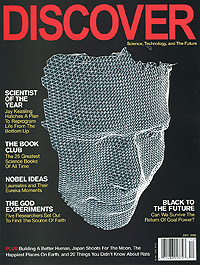Berkeleyan
Keasling is 'Scientist of the Year'
Discover magazine lauds Berkeley bioengineer for his pioneering work in synthetic biology
![]()
| 29 November 2006
 |
Discover magazine has named Jay Keasling, professor of chemical engineering and bioengineering, its 2006 Scientist of the Year for his ambitious efforts to "rebuild life itself." The announcement of the honor, and a Q&A with Keasling, appear in the magazine's December issue.
This is the first year Discover has accorded the honor, and Keasling beat out two hot runners-up: Svante Pääbo, director of evolutionary genetics at the Max Planck Institute for Evolutionary Anthropology in Leipzig, who is sequencing the genome of Neanderthals, among other extinct animals; and John Donoghue, a Brown University neuroscientist who is developing devices that can help people who have lost the ability to move their limbs.
Keasling is a leader in the nascent field of synthetic biology, which reaches beyond simple genetic engineering of organisms to a complete genomic makeover, treating genes "like transistors wired in a circuit," writes Carl Zimmer in Discover. By mixing and matching genes inside the bodies of microbes, Keasling and his colleagues hope to turn bacteria or yeast into factories for a broad range of useful products, not just the drugs on which the biotech industry focuses.
Zimmer adds, "Fighting malaria is just one part of Keasling's larger agenda to explore the staggering potential of synthetic biology. In his laboratory, students are engineering microbes to break down pesticides, make biodegradable plastics, and create ethanol and other fuels from plants."
Keasling is head of the synthetic biology department at Lawrence Berkeley National Laboratory and director of the Synthetic Biology Engineering Research Center (SynBERC), which is headquartered at Berkeley but involves scientists from universities around the country. Keasling also is a member of the California Institute for Quantitative Biomedical Research (QB3), a partnership between the state of California, industry, and the UC campuses at San Francisco, Berkeley, and Santa Cruz.
The complete article (and a Q&A with Keasling) is in Discover's December issue, now on newsstands; it can be read online (registration required) at www.discover.com/issues/dec-06.
More ink for Keasling - and a raft of Berkeley innovators
A profile of Keasling also appears in the current issue of California magazine, published by the California Alumni Association (alumni.berkeley.edu/calmag/200611/corcoran.asp). Author Elizabeth Corcoran provides more insight into Keasling's early influences and academic trajectory - not to mention the difficulties he once had obtaining samples of artemisinin to work with, and his current affection for Italian shoes - than was possible in Discover's all-business treatment.
 Jay Keasling (Peg Skorpinski photo) |

